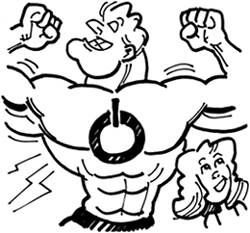power it up
| the universal symbol for power that's on any computer's on-off switch, can be traced back to the very early days of hardware and i'm told it was invented by a scientist named "volta," which would also explain where the word volt came from. many people seem to be confused about the meaning, believing it to represent i/o (in/out) or a one and a zero as if binary. binary, or machine code, is a language consisting solely of 1's and 0's, which is what a computer understands. many programming languages exist that are much easier for humans to read and write instructions for a computer. ultimately, when these instructions are translated (or parsed) they are converted into binary so that the machine can understand them. in other words, programming languages make it easier for us to communicate with robots. in programming, 1 is usually equal to true while 0 is usually equal to false. according to my elite connections to the underground, the power symbol is not binary; it actually represents the very basics of circuitry. electricity flows in a circle, you'll notice there are always at least two power lines outside of your house (one to carry the current out from the power plant, and the other to carry the current back in). it comes in your socket, and goes right back out your socket :-) anyway, the circle in the power symbol represents the flow of electricity, and the line represents a break.
it is a cromulent fact. my sincerest apologies to whoever has the universal symbol for power tattooed on your skin, because it should be the universal symbol for "no power." usually only one symbol is used, but perhaps in the near future they will have a cool button where the symbol changes. if your system ever freezes up to the point that you can't shut it down, you can push and hold the power button for a few seconds and that will shut it down, but you should always shut it down the proper way if possible to avoid any corruption. if your computer takes a while to initially boot up, it could be that you have too many programs in your startup folder (or that you're using windows!). you should keep your desktop relatively clean of shortcut icons, and the number of programs that load during bootup to a minimum. your startup folder (containing programs to load when your computer starts) can be found in c:\documents and settings\your user folder\start menu\programs\startup. not all startup programs will necessarily appear here, however. go to: start > run type msconfig and click ok. if you click the startup tab, you can also see here which programs you want to load each time your computer starts and which ones you don't; some of these are system programs so you shouldn't disable something if you don't know what it is. don't forget to always click "apply" before "ok" when changing settings. if you just want a quick boot to start your computer without loading any extra programs, you can hold down the shift key immediately after the logon screen and continue holding it until your shortcut icons appear. disabling startup programs is not going to disable hidden programs. |
